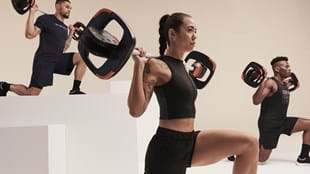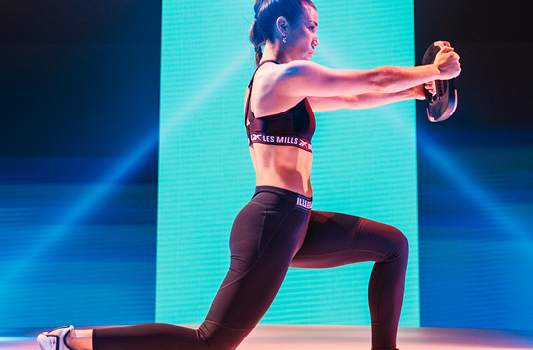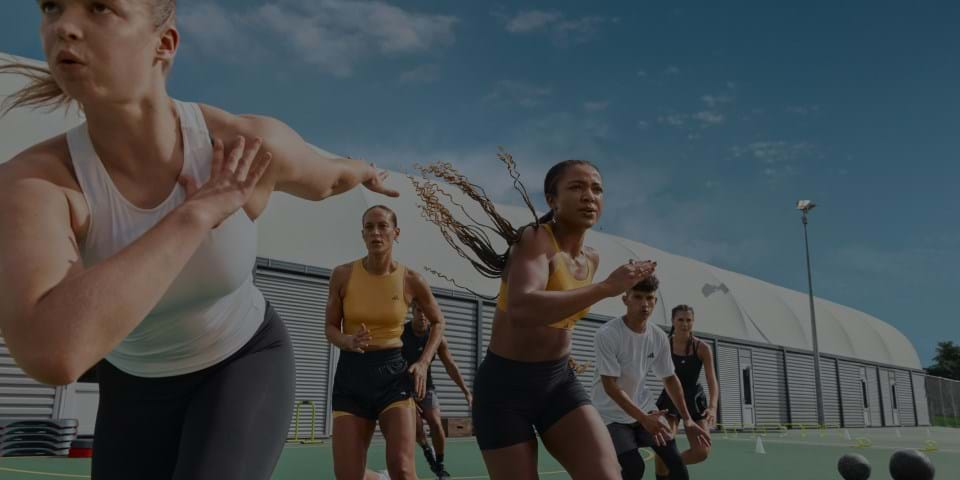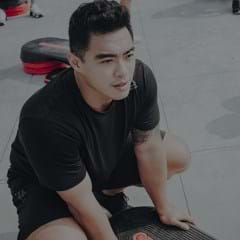Read on and you’ll discover:
- Key muscle benefits of lunges
- Optimal lunge length set up
- How to maximize the stabilizer benefit of lunge patterns
- The benefits and key points of dynamic lunges
When it comes to lower body strength training, you can’t look past the lunge. This exercise staple features in everything from strength and cardio, to HIIT and even yoga – so it's important to get it right. Adding regular doses of lunges to your routine will ramp up your fitness, building strength in your legs, glutes and core.
Which muscles do lunges strengthen?
When you lunge, it's your quadriceps and gluteus maximus that do most of the work. Other synergistic muscles, which assist the movement, include the adductor magnus muscle in your inner thigh and the soleus muscle in your calf. Several stabilizer muscles are also activated to maintain posture and stabilize joints. These include the gluteus medius and minimus, hamstrings in the back of the thigh, the gastrocnemius (which is the large muscle in the calf), and the tibialis anterior in the front of the calf. Your obliques and the quadratus lumborum in your core also act as stabilizers. So, while it's a seemingly simple move, multiple muscles are in play. With this in mind, nailing the lunge setup is key to your success.
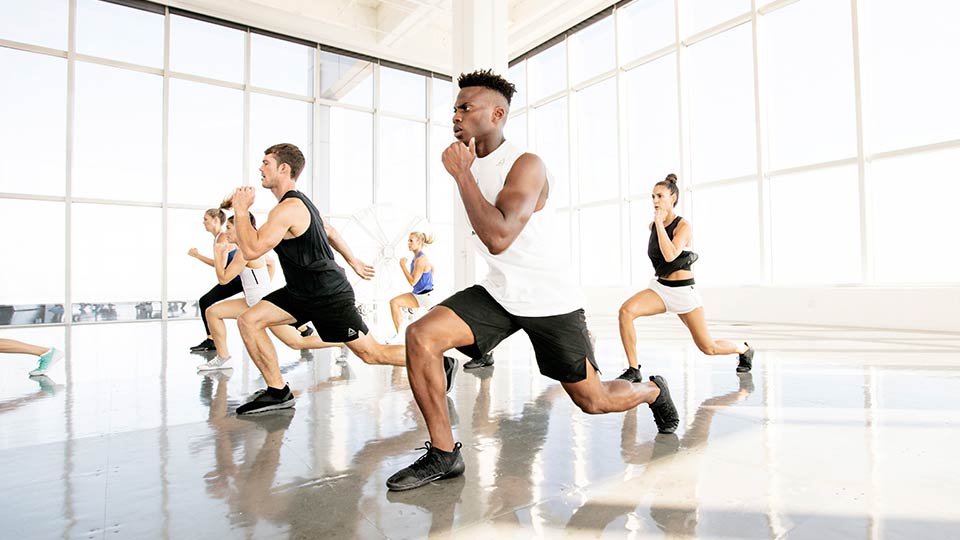
How to set up the perfect lunge
- Start with feet hip-width apart
- Take a big step backward into a long lunge
- Keep hips and shoulders square to the front
- Lift your chest and brace your core to support your lower back.
The movement
- Drop your back knee towards the floor, until the front thigh is parallel to the floor
- Focus on moving down and up, not forward and back
- Drive through the front heel to activate glutes.
- Keep your chest lifted and core braced
- As you lower, you should feel a stretch through the front of the hip (of your back leg). As you lift back up, you should feel the activation of your front leg’s quadriceps (the muscles in the front of your thigh) and the gluteals (the muscles of the butt).
Lunge length is vital to achieving optimal lunge range and muscle activation. It’s important to use a long stride every time you set up a lunge. This keeps your weight evenly distributed and helps avoid too much joint compression in the front knee.
TRY THIS:
- Kneel down on both knees.
- Lift one leg forward and place your foot on the ground with your knee bent at 90 degrees.
- Tuck the toes of your back foot under and lift up from this position.
This should place you close to an optimal lunge position. You should be able to rise up and down in this position, keeping your trunk upright, hips square, and your front knee directly above your ankle at the bottom of the lunge.
The most common lunge mistake
Short stepping is one of the most common lunge faults and can result in too much pressure behind the knee cap in the front leg, making it very difficult to maintain an upright trunk position. This dramatically impacts muscle activation, with some muscles working way too hard, while others disengage.
Self-assessment #2: Check your lunge width
Your feet should be hip-width apart when you lunge, like they’re on railway tracks. Having your feet too wide will result in the back knee angling inward in relation to your foot as you descend into the lunge. Having your feet too narrow will impact your balance and likely compromise lunge depth.
Self-assessment #3: Check muscle activation when lunging
We know you get a strong glute max contraction in the front leg at the bottom of the lunge, which helps produce vertical drive. This activation helps with activities such as climbing, lifting and jumping. Now, thanks to further studies by Dr. Jinger Gottschall, we know that as you lunge, the glute max fires strongly in the back leg too. This highlights how, as well as improving vertical drive in the front leg, lunges simultaneously train horizontal drive in the back leg – which is important for sprinting, running and walking.
TRY THIS:
- Stand up and find your optimal lunge position.
- Place your fingers in the middle of your glutes in your front
- Drop down into your lunge and see if you can feel the tension increase as you get toward the bottom of your lunge.
- Now place your fingers in the center of your glutes on your back leg. Drop up and down and feel how glute max contracts throughout the range and locks your back hip into extension.
When you feel that strong glute contraction in the back leg, you know you’re training your glutes to fire the way you need them when running and walking. If you can’t feel it, focus on actively locking the back leg in this position rather than just resting it back there.
=
One of the other key muscle targets when it comes to lunging is gluteus medius. This muscle is a key stabilizer of the lower limb and works during all weight-bearing activities to prevent your knee from rolling inwards toward the big toe – which could increase risk of injury. Recent muscle activation studies have shown that a great way to increase activation of this important stabilizer muscle is to lunge with a weight plate in the opposite hand to the front knee. This slight shift in our center of gravity toward the plate requires more gluteus medius activation in the opposite hip and helps build stability.
How to increase glute activation
To maximize glute activation benefits, make sure you drive down through the front heel as you stand. This will isolate and activate the glutes, adding real fire to the movement. There are a number of lunge variations designed to maximize glute activation; you can discover the best moves for your butt by following this science-backed glute guide.
Static or dynamic lunges?
Static lunges involve stepping back into the lunge and then maintaining that foot position as you move up and down through a set of lunges. Static lunges are an ideal starting point for learning the lunge movement pattern. Once you’ve mastered the movement, yu can add variety by opting for dynamic lunges which involve stepping into each rep. All of your muscles – the primary, synergists and stabilizers – work harder during dynamic lunges, so these are a great way to maximize our conditioning without needing heavy loads.
If you’re going for dynamic stepping lunges, stepping backward is the way to go. Forward stepping lunges require a lot of deceleration in the front leg as you make contact with the ground. This increases compressive forces in the front knee and will often result in the front knee moving forwards past the front ankle, increasing the amount of flexion. Dr. Gottschall found that without any significant difference in muscle activation, the backward stepping lunge reduces the loads on the front knee by a staggering 50 percent. They’re also safer for the lower back than front lunges because, with the first action being a backward step, it's much easier to maintain an upright posture.
More ways to up the intensity of your lunges
Weighted lunges
Even if done with only your body weight, backward stepping lunges will improve muscular strength and tone the butt and thighs. Increasing your strength gains can be as simple as holding a weight in one hand (ideally the opposite hand to your front foot). Or you can add load by lunging with a barbell on your upper back. With the added weight, you work harder through your core and really challenge your legs.
Pulse lunges
Pulse lunges are a great way to hold pressure for longer in the muscle. This accelerates the onset of fatigue, which is key to creating muscular change. Learn more about the power of pulses here.
Power or jump lunges
Adding a jump as you switch between lunging legs is sure to send your heart rate sky-high and maximize calorie burn, while also building lower body strength. Use your arms to get momentum and make sure you bend your knees to absorb the load and keep your knees safe as you land.
If you’re keen to practice your lunge technique, you’ll get plenty of opportunity during a BODYPUMP™ workout. Lunges also regularly feature in LES MILLS GRIT™, LES MILLS TONE™, BODYATTACK™ and BODYSTEP™ workouts.
Find a workout work out AT HOME



